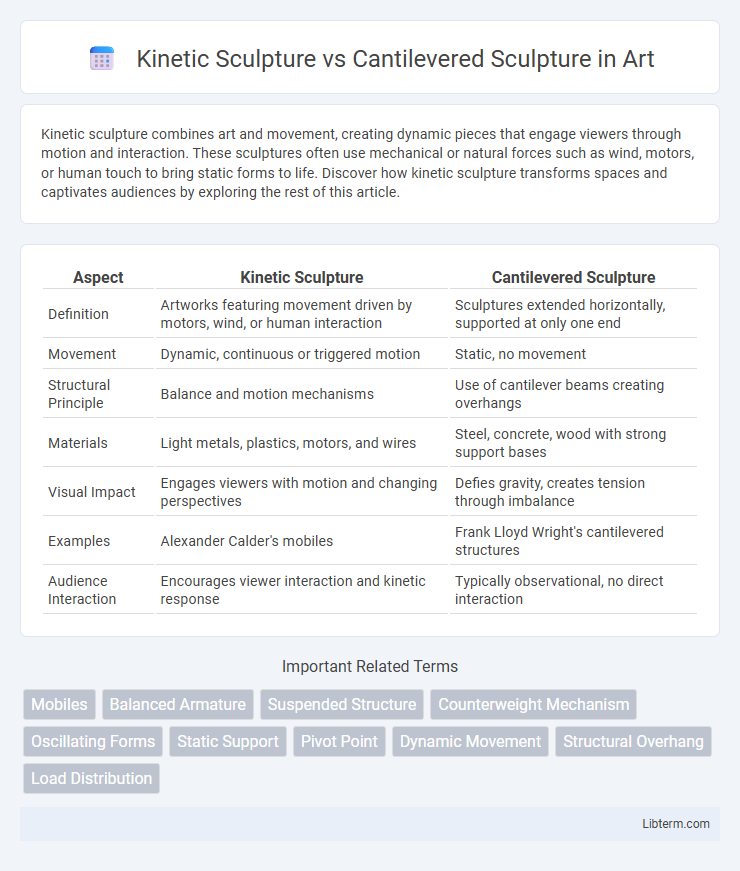Kinetic sculpture combines art and movement, creating dynamic pieces that engage viewers through motion and interaction. These sculptures often use mechanical or natural forces such as wind, motors, or human touch to bring static forms to life. Discover how kinetic sculpture transforms spaces and captivates audiences by exploring the rest of this article.
Table of Comparison
| Aspect | Kinetic Sculpture | Cantilevered Sculpture |
|---|---|---|
| Definition | Artworks featuring movement driven by motors, wind, or human interaction | Sculptures extended horizontally, supported at only one end |
| Movement | Dynamic, continuous or triggered motion | Static, no movement |
| Structural Principle | Balance and motion mechanisms | Use of cantilever beams creating overhangs |
| Materials | Light metals, plastics, motors, and wires | Steel, concrete, wood with strong support bases |
| Visual Impact | Engages viewers with motion and changing perspectives | Defies gravity, creates tension through imbalance |
| Examples | Alexander Calder's mobiles | Frank Lloyd Wright's cantilevered structures |
| Audience Interaction | Encourages viewer interaction and kinetic response | Typically observational, no direct interaction |
Introduction to Kinetic Sculpture
Kinetic sculpture is a form of art that incorporates movement as a fundamental aspect, often powered by wind, motors, or human interaction. Unlike cantilevered sculpture, which emphasizes balance and projection without additional motion, kinetic sculpture engages viewers through dynamic motion, transforming static materials into captivating, evolving forms. This interplay of mechanics and aesthetics highlights the innovation and complexity within contemporary sculpture practices.
Defining Cantilevered Sculpture
Cantilevered sculpture is characterized by its use of projecting beams or elements anchored at only one end, creating a sense of balance and tension through unsupported spans. This form contrasts with kinetic sculpture, which incorporates movement as a fundamental aspect of its design, often powered by wind, motors, or viewer interaction. Cantilevered sculptures emphasize structural integrity and visual equilibrium without relying on dynamic motion.
Historical Evolution of Both Styles
Kinetic sculpture emerged in the early 20th century, pioneered by artists like Alexander Calder who integrated movement through motors or air currents to challenge static traditional forms. Cantilevered sculpture traces its roots to architectural principles, gaining prominence in the mid-20th century as sculptors such as Henry Moore exploited balance and tension to create visually dynamic, seemingly floating structures. Both styles reflect evolving artistic explorations of space and form, with kinetic art emphasizing motion and cantilevered art focusing on equilibrium and structural innovation.
Key Materials and Construction Techniques
Kinetic sculptures primarily use lightweight metals like aluminum and steel combined with motors, gears, and bearings to enable movement, requiring precise engineering for dynamic balance and motion control. Cantilevered sculptures rely on robust materials such as reinforced steel, concrete, and engineered wood, utilizing counterweights and structural supports to create overhanging forms without visible bracing. Construction techniques for kinetic sculptures emphasize mechanical assembly and dynamic testing, whereas cantilevered sculptures focus on static load analysis and material strength optimization.
Movement Versus Balance: Core Concepts
Kinetic sculptures emphasize movement through mechanical or natural forces, creating dynamic visual experiences that change over time. Cantilevered sculptures prioritize balance by projecting elements horizontally, relying on counterweights and structural integrity to achieve stability. Understanding these core concepts highlights the contrast between motion-driven interaction and static equilibrium in sculptural design.
Influential Artists in Each Genre
Alexander Calder revolutionized kinetic sculpture with his intricate mobiles that harness wind and motion, creating dynamic art pieces that interact with their environment. In contrast, Harry Bertoia made significant contributions to cantilevered sculpture, designing compositions that balance extended forms without traditional supports, emphasizing structural tension and elegance. Both artists pushed the boundaries of form and space, defining the foundational principles of their respective genres.
Aesthetic Appeal and Visual Impact
Kinetic sculptures captivate through dynamic movement and changing perspectives, creating an engaging and ever-evolving visual experience that interacts with natural elements like wind or human touch. Cantilevered sculptures emphasize balance and tension, often presenting bold, dramatic forms that appear to defy gravity, enhancing architectural integration and spatial dialogue. Both styles command attention; kinetic works offer fluidity and transformation, while cantilevered pieces underscore stability and structural ingenuity.
Structural Challenges and Solutions
Kinetic sculptures face structural challenges related to dynamic balance, motorized movement, and weather resistance, requiring lightweight materials like aluminum and precise engineering for stability and fluid motion. Cantilevered sculptures must address the distribution of stress and counterbalance to prevent tipping or material fatigue, often solved by using reinforced steel frameworks and anchoring systems. Both types demand careful calculation of load-bearing capacities and flexibility in design to maintain structural integrity under varying environmental conditions.
Integration with Environment and Space
Kinetic sculptures dynamically interact with their environment through movement, responding to wind, light, or human touch, thereby creating a constantly evolving relationship with the surrounding space. Cantilevered sculptures emphasize balance and tension, often extending into open space without visible support, establishing a striking visual dialogue with their structural environment. Both forms enhance spatial perception--kinetic works through fluid motion and changing perspectives, cantilevered pieces through bold projection and engineered stability.
Choosing Between Kinetic and Cantilevered Sculpture
Choosing between kinetic and cantilevered sculpture depends on the desired interaction and visual impact; kinetic sculptures incorporate movement, creating dynamic, ever-changing forms that engage viewers through motion and energy. Cantilevered sculptures emphasize structural balance and tension, relying on extended forms anchored at a single point to create a sense of suspension and gravity-defying elegance. Consider site conditions and maintenance requirements, as kinetic pieces often need mechanical components and power sources, while cantilevered works prioritize material strength and architectural integration.
Kinetic Sculpture Infographic

 libterm.com
libterm.com